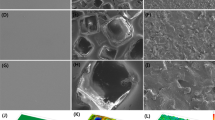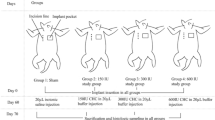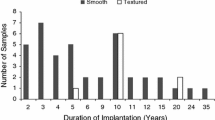Abstract
Silicone implants have been used for breast augmentation for more than 45 years. Complications, in particular capsular contracture, occur with an incidence of <10% and up to 60%. We investigated the influence of the surface of breast implants on the formation of capsular contracture by comparing silicone with titanium-coated silicone. Seventeen smooth saline-filled silicone (group A) and 14 saline-filled titanium-coated silicone (group B) implants were implanted in female Wistar rats. After 12 and 36 weeks, the implants and capsules were extracted; histological and immunohistochemical staining was performed. The evaluation of the capsules was performed by two examiners in a double-blinded manner. Histologically, no significant difference in total capsule thickness was found. There was a significant difference in synovial-like metaplasia layer (SLM) thickness between groups A and B (p = 0.041). Regarding implantation time (12 vs. 36 weeks), a significant difference was found in SLM thickness (p = 0.021). Immunohistochemical staining indicated a significantly lower infiltration with inflammatory cells in group B. A significant correlation (p = 0.019) between a thick SLM layer and inflammatory cell infiltration was detected. Titanium-coated silicone implants reduce SLM thickness and capsular inflammatory cell infiltration. These findings postulate that titanium-coated silicone implants might point out a new chance in the prevention of capsular contracture.
Access this article
We’re sorry, something doesn't seem to be working properly.
Please try refreshing the page. If that doesn't work, please contact support so we can address the problem.






Similar content being viewed by others
References
Cronin TDGF (1963) Augmentation mammaplasty: a new "natural feel" prosthesis. Excerpta Medica International Congress Series 66:41
Gampper TJ, Khoury H, Gottlieb W, Morgan RF (2007) Silicone gel implants in breast augmentation and reconstruction. Ann Plast Surg 59(5):581–590
Gabriel SE, Woods JE, O'Fallon WM, Beard CM, Kurland LT, Melton LJ 3rd (1997) Complications leading to surgery after breast implantation. N Engl J Med 336(10):677–682
Del Pozo JL, Tran NV, Petty PM, Johnson CH, Walsh MF, Bite U, Clay RP, Mandrekar JN, Piper KE, Steckelberg JM, Patel R (2009) Pilot study of association of bacteria on breast implants with capsular contracture. J Clin Microbiol 47(5):1333–1337
Poeppl N, Schreml S, Lichtenegger F, Lenich A, Eisenmann-Klein M, Prantl L (2007) Does the surface structure of implants have an impact on the formation of a capsular contracture? Aesthet Plast Surg 31(2):133–139
Siggelkow W, Faridi A, Spiritus K, Klinge U, Rath W, Klosterhalfen B (2003) Histological analysis of silicone breast implant capsules and correlation with capsular contracture. Biomaterials 24(6):1101–1109
Handel N, Jensen JA, Black Q, Waisman JR, Silverstein MJ (1995) The fate of breast implants: a critical analysis of complications and outcomes. Plast Reconstr Surg 96(7):1521–1533
Stevens WG, Pacella SJ, Gear AJ, Freeman ME, McWhorter C, Tenenbaum MJ, Stoker DA (2008) Clinical experience with a fourth-generation textured silicone gel breast implant: a review of 1012 mentor memorygel breast implants. Aesthet Surg J 28(6):642–647
Spear SL, Murphy DK, Slicton A, Walker PS (2007) Inamed silicone breast implant core study results at 6 years. Plast Reconstr Surg 120(7 Suppl 1):8S–16S, discussion 17S–18S
Cunningham B (2007) The Mentor Core Study on Silicone Memorygel Breast Implants. Plast Reconstr Surg 120(7 Suppl 1):19S–29S, discussion 30S–32S
Wong CH, Samuel M, Tan BK, Song C (2006) Capsular contracture in subglandular breast augmentation with textured versus smooth breast implants: a systematic review. Plast Reconstr Surg 118(5):1224–1236
Schardey HM, Schopf S, Rudert W, Knappich P, Hernandez-Richter T (2004) Titanised polypropylene meshes: first clinical experience with the implantation in TAPP technique and the results of a survey in 22 German surgical departments. Zentralbl Chir 129(5):363–368
Arens S, Schlegel U, Printzen G, Ziegler WJ, Perren SM, Hansis M (1996) Influence of materials for fixation implants on local infection. An experimental study of steel versus titanium DCP in rabbits. J Bone Joint Surg Br 78(4):647–651
Copeland M, Choi M, Bleiweiss IJ (1994) Silicone breakdown and capsular synovial metaplasia in textured-wall saline breast prostheses. Plast Reconstr Surg 94(5):628–633, discussion 634–626
Raso DS, Greene WB, Metcalf JS (1994) Synovial metaplasia of a periprosthetic breast capsule. Arch Pathol Lab Med 118(3):249–251
Raso DS, Crymes LW, Metcalf JS (1994) Histological assessment of fifty breast capsules from smooth and textured augmentation and reconstruction mammoplasty prostheses with emphasis on the role of synovial metaplasia. Mod Pathol 7(3):310–316
Wyatt LE, Sinow JD, Wollman JS, Sami DA, Miller TA (1998) The influence of time on human breast capsule histology: smooth and textured silicone-surfaced implants. Plast Reconstr Surg 102(6):1922–1931
Ko CY, Ahn CY, Ko J, Chopra W, Shaw WW (1996) Capsular synovial metaplasia as a common response to both textured and smooth implants. Plast Reconstr Surg 97(7):1427–1433, discussion 1434–1425
Rubino C, Mazzarello V, Farace F, D'Andrea F, Montella A, Fenu G, Campus GV (2001) Ultrastructural anatomy of contracted capsules around textured implants in augmented breasts. Ann Plast Surg 46(2):95–102
Kamel M, Protzner K, Fornasier V, Peters W, Smith D, Ibanez D (2001) The peri-implant breast capsule: an immunophenotypic study of capsules taken at explantation surgery. J Biomed Mater Res 58(1):88–96
Schreml S, Heine N, Eisenmann-Klein M, Prantl L (2007) Bacterial colonization is of major relevance for high-grade capsular contracture after augmentation mammaplasty. Ann Plast Surg 59(2):126–130
Hernandez-Richter T, Wittmann B, Wittmann F, Loehe F, Rentsch M, Mayr S, Jauch KW, Angele MK (2007) Titanium-coated silicone is not effective for preventing graft infection. Zentralbl Chir 132(1):32–37
Scheidbach H, Tamme C, Tannapfel A, Lippert H, Kockerling F (2004) In vivo studies comparing the biocompatibility of various polypropylene meshes and their handling properties during endoscopic total extraperitoneal (TEP) patchplasty: an experimental study in pigs. Surg Endosc 18(2):211–220
Zimman OA, Toblli J, Stella I, Ferder M, Ferder L, Inserra F (2007) The effects of angiotensin-converting-enzyme inhibitors on the fibrous envelope around mammary implants. Plast Reconstr Surg 120(7):2025–2033
Ulrich D, Lichtenegger F, Eblenkamp M, Repper D, Pallua N (2004) Matrix metalloproteinases, tissue inhibitors of metalloproteinases, aminoterminal propeptide of procollagen type III, and hyaluronan in sera and tissue of patients with capsular contracture after augmentation with Trilucent breast implants. Plast Reconstr Surg 114(1):229–236
Author information
Authors and Affiliations
Corresponding author
Rights and permissions
About this article
Cite this article
Bergmann, P.A., Lange, T., Siemers, F. et al. Histological analysis of capsule formation around silicone implants and comparison with titanium-coated silicone implants in rats. Eur J Plast Surg 35, 19–24 (2012). https://doi.org/10.1007/s00238-011-0579-9
Received:
Accepted:
Published:
Issue Date:
DOI: https://doi.org/10.1007/s00238-011-0579-9




